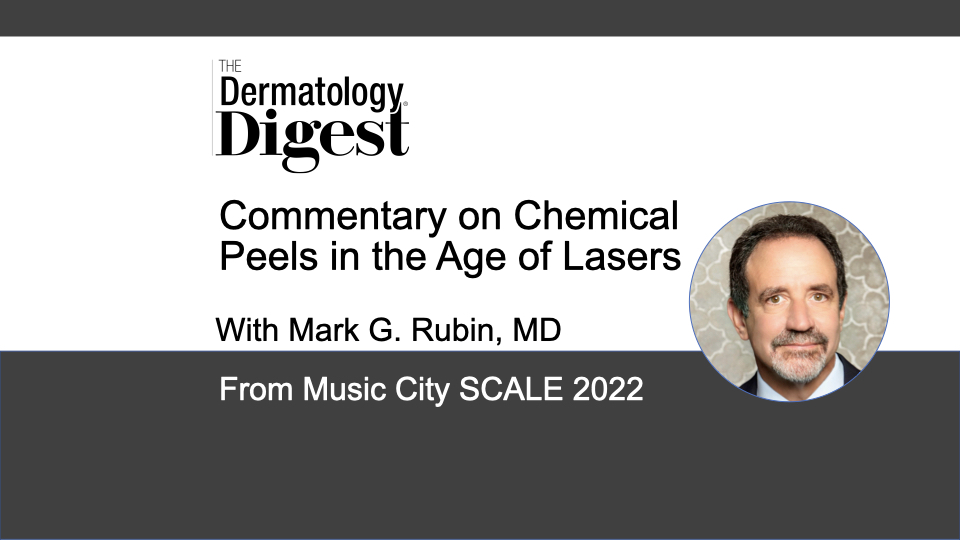Dr. Mark G. Rubin compares chemical peeling to laser treatment for treating facial and nonfacial skin issues.
Mark G. Rubin, MD, is a board-certified dermatologist, Lasky Clinic, Beverly Hills, California
“So the whole concept of chemical peels in the age of lasers is that everybody’s become infatuated, obviously, with laser technology because it’s new, exciting, [and] it’s what patients want. But…you could use older therapies and still do just as well,” said Mark G. Rubin, MD, who presented “Chemical Peels in the Age of Lasers” at the Symposium for Cosmetic Advances & Laser Education (SCALE) 2022.
“For facial problems that are epidermal, a chemical peel is just as good as any of the lasers,” he said.
Superficial epidermal issues include skin color, texture, radiance, and pore size.
According to Dr. Rubin, the question is, “…how many cells are you going to kill? It doesn’t matter how you kill them. If you kill them with a laser or you kill them with a chemical burn, a dead cell is a dead cell. And if you get rid of all the bad ones, the skin looks great no matter how you’ve done it.”
While both a chemical peel and ablative laser can be used to treat the superficial epidermis, deeper issues, including wrinkles, skin atrophy, and loss of elasticity, and nonfacial areas require additional consideration, he said.
“When you get to the neck and the chest, now you’re dealing with skin that doesn’t heal as easily and takes longer to heal. So in those areas, fractional lasers are far safer because you’re not wounding all that skin… There’s much less risk, but they’ll need to be treated more than a single time to get a profound result.”
The face has 30 times more pilosebaceous units per square inch than the neck or chest and 40 times more than that on the arms or back of the hands, said Dr. Rubin.
“What that means is, is if you’re treating a nonfacial area, it’s [not only] a lot harder for that area to heal…but the longer it takes to heal, the greater the chance of an infection or persistent redness leading to [risk of] increased post inflammatory hyperpigmentation.”
And then there’s selective photothermolysis, said Dr. Rubin.
“You can treat a dilated blood vessel in somebody’s cheek with a specific wavelength of light. [It] passes through the skin, and it dumps its energy in the blood vessel, heats the vessel, and …shrinks it with no surrounding damage.”
‘Profound’ Treatment
When selecting the right treatment, there are specific scenarios to consider, said Dr. Rubin.
“If it’s a patient who comes in who has traditional sun damage issues, which are usually rough texture, blotchy pigmentation, maybe some large pores, those issues can be treated with any of these modalities, but if they’re looking for a profound result, and they’re willing to give you five to seven days of healing time, a chemical peel, like a medium depth TCA chemical peel, does an amazing job with that.”
Likewise, a fully ablative laser to the epidermis also takes about a week to heal and delivers a profound result, said Dr. Rubin.
“If the patient only has a long weekend, it’s pretty hard to do anything that’s fully ablative with a laser or with a peel and having that patient heal in time.”
For patients with limited time, a fractional laser may be the better option, he said.
“They’ll heal faster, and it’s not as nasty looking when they look in the mirror while they’re healing. But you haven’t eliminated all of their problem because you haven’t destroyed all the damaged cells; you’ve only destroyed a fraction of them.”
Choose pigment-specific lasers over chemical peels for treating nonfacial areas, said Dr. Rubin.
“For nonfacial areas, I think patients do better very often with lasers, but again, pigment-specific and/or nonablative.”
Likewise, a fractional, non-ablative laser is a better choice for improving overall skin quality, he said.
“Chemical peels in that area can’t go that deep. You can’t do nearly as well.”
A deep chemical peel, however, will deliver the most profound result for other issues, including lax skin and wrinkles, he said.
“That induces more collagen growth than anything else.”
The downside to a deep chemical peel is healing time, said Dr. Rubin.
“People stay red for months afterwards. There’s significant risk of having loss of pigment and getting a very white tone to their skin. A lot of patients don’t want that that risk or that chance so they’ll go with a fully ablative-type of a CO2 laser instead.”
Although the laser is safer, skin tightening results aren’t as good as those that can be achieved with a deep chemical peel, he said.
“And if those patients really don’t have the downtime, or they’re adverse to the risk of a fully ablative carbon dioxide laser, then they could go to a fractional-type of a laser instead. And you’re only influencing a fraction of the cells, so the result’s not as profound but they’re going to heal a lot faster.”
Disclosure: Dr. Rubin reports no relevant disclosures.


